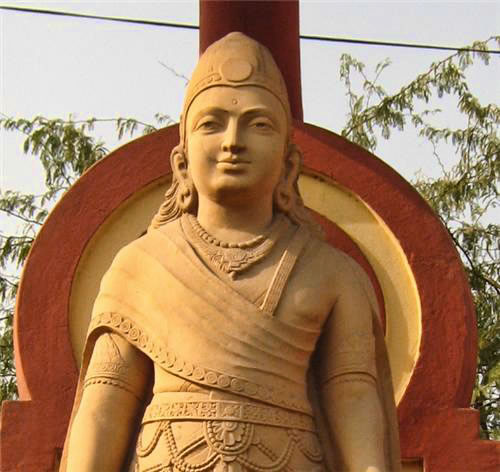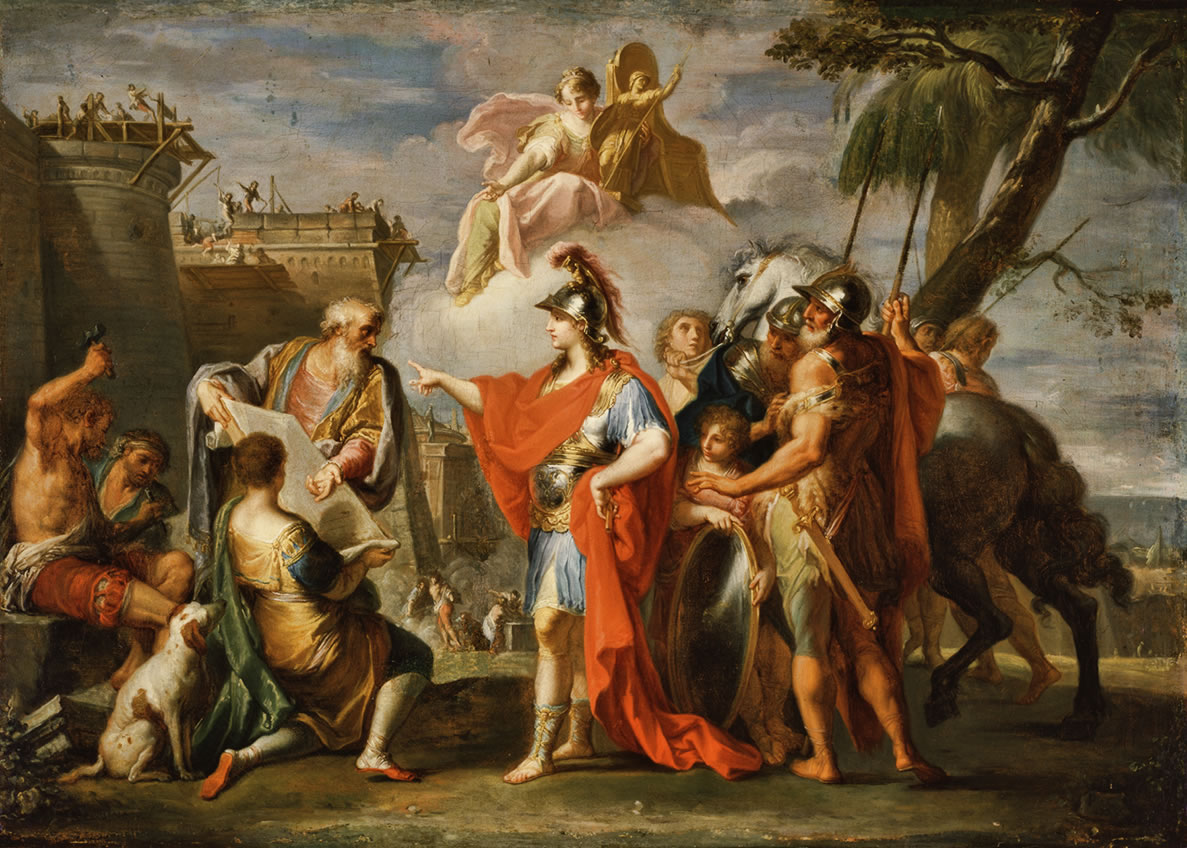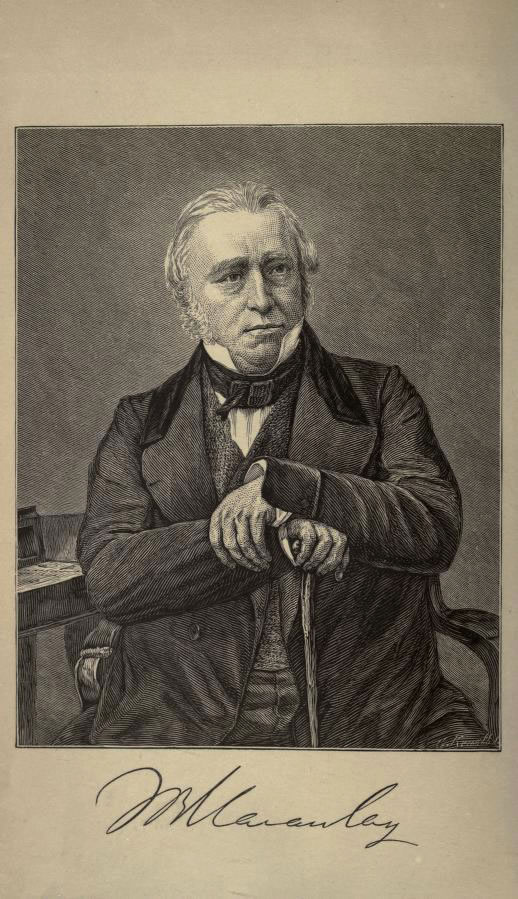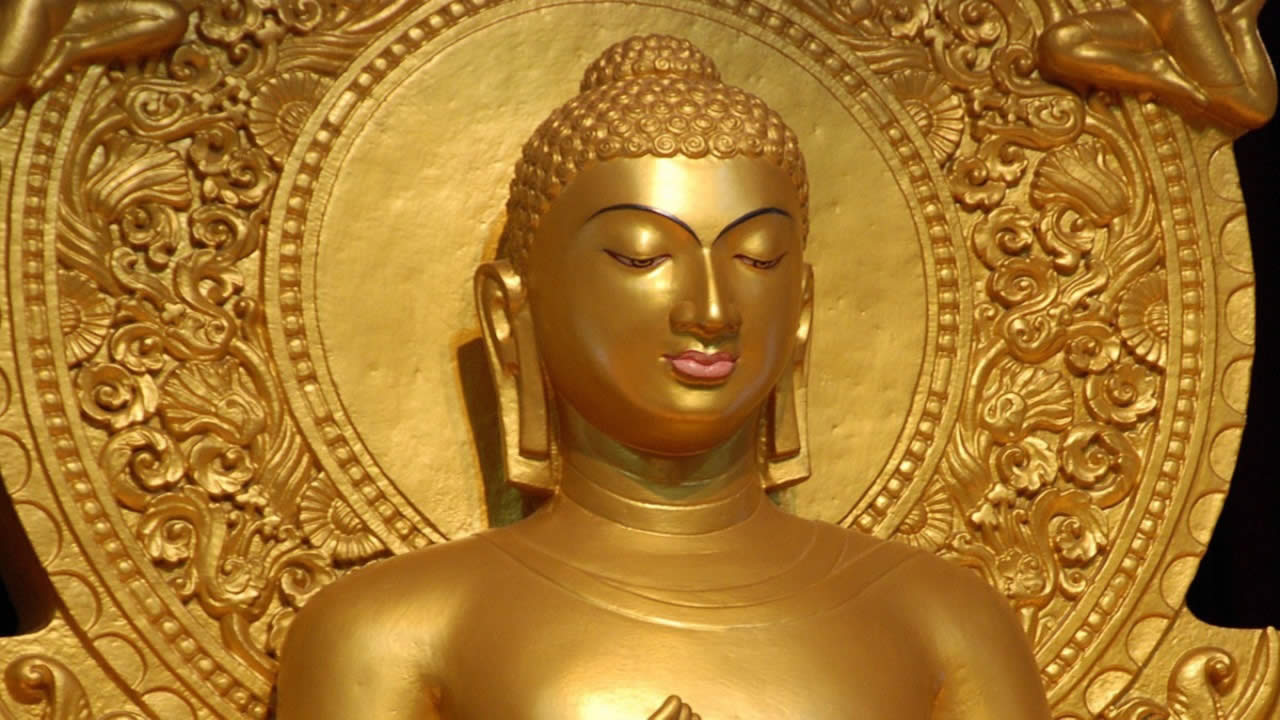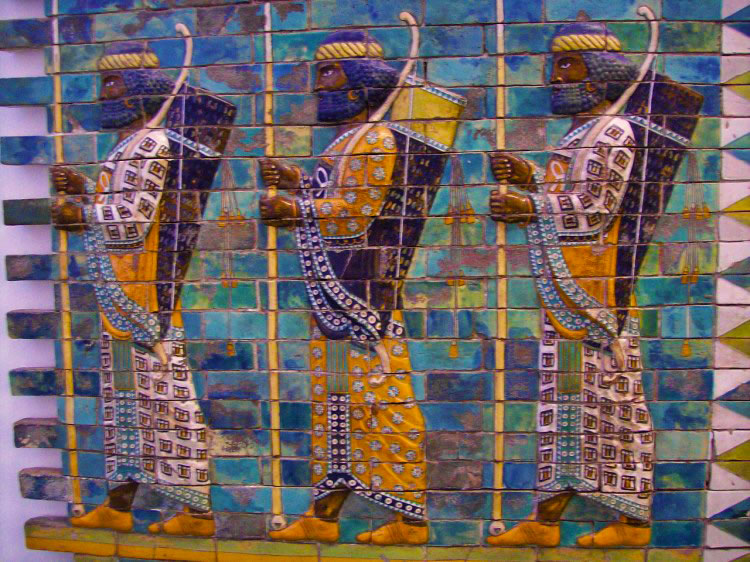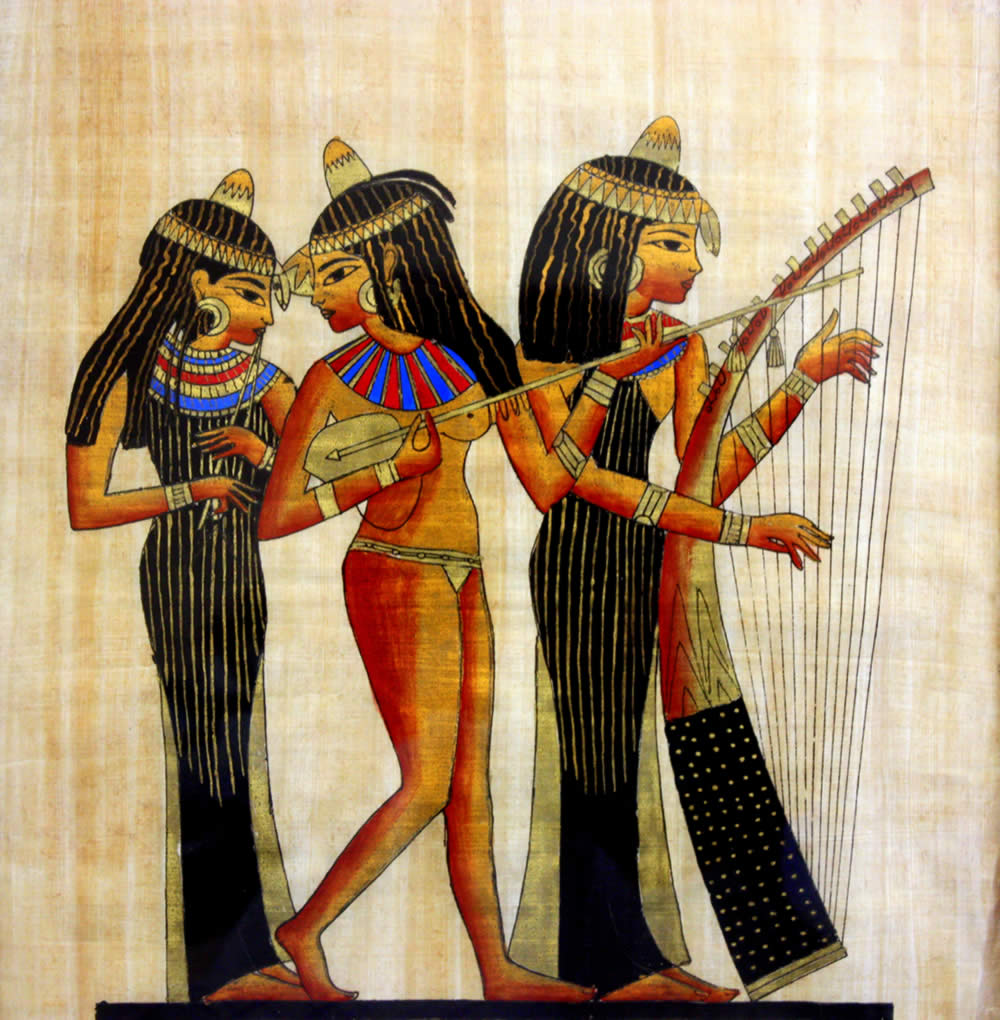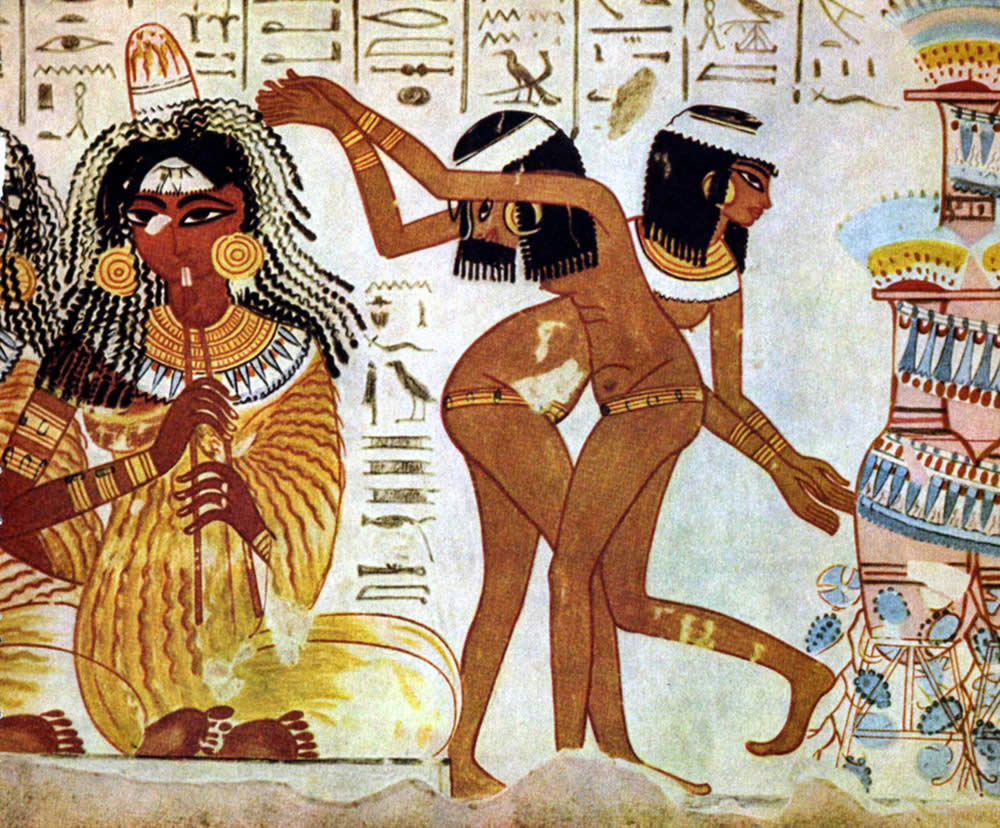Was Alexander the Great a
Contemporary
of Canakya Pandit? – the Puranic Version
Shyamasundara Dasa
Copyright © 2015-2016
This was originally a public email exchange between myself and His Grace Ganesha Prabhu on Jan 16, 2008, while I was in Delhi recoperating from the injuries sustained in a car accident. I have edited and enlarged on it for the sake of completion.
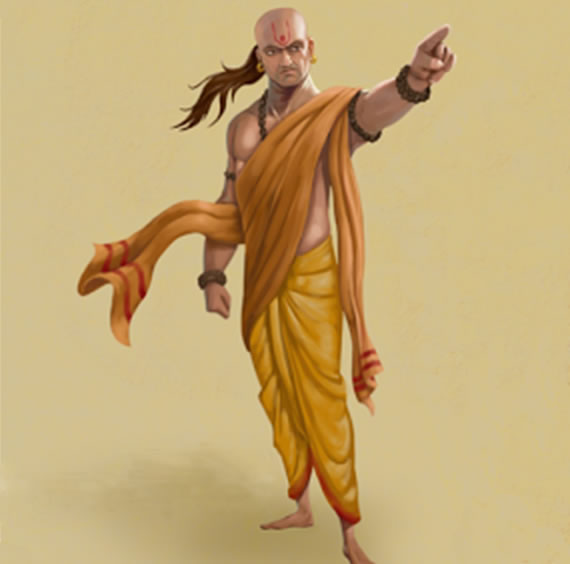
Canakya Pandit
Dear Maharajas, Prabhus and Matajis,
Please accept my humble obeisance. All glories to Srila Prabhupada. Bhakti-vighna-vinasa Narasimhadeva Bhagavan ki jaya!
I wrote:
However the depiction of Canakya as a contemporary of Alexander the Great is a common misconception first propagated by the British but not supported by Sastra. Canakya was from 16th century BC not 4th century BC.
Ganesha Prabhu responded:
This statement is not according to Srila Prabhupada's words.
Srila Prabhupada:
"That is a fact-the brahmanas were accepted. They formed the advisory
committee of the king. For example, Candragupta, the Hindu king, was in
the age of Alexander the Great. Just before Candragupta, Alexander the
Great went from Greece into India and conquered a portion. When
Candragupta became emperor, he had Canakya as his prime minister. Perhaps
you have heard this name Canakya?” Science of Self Realization
ys ganesadasa
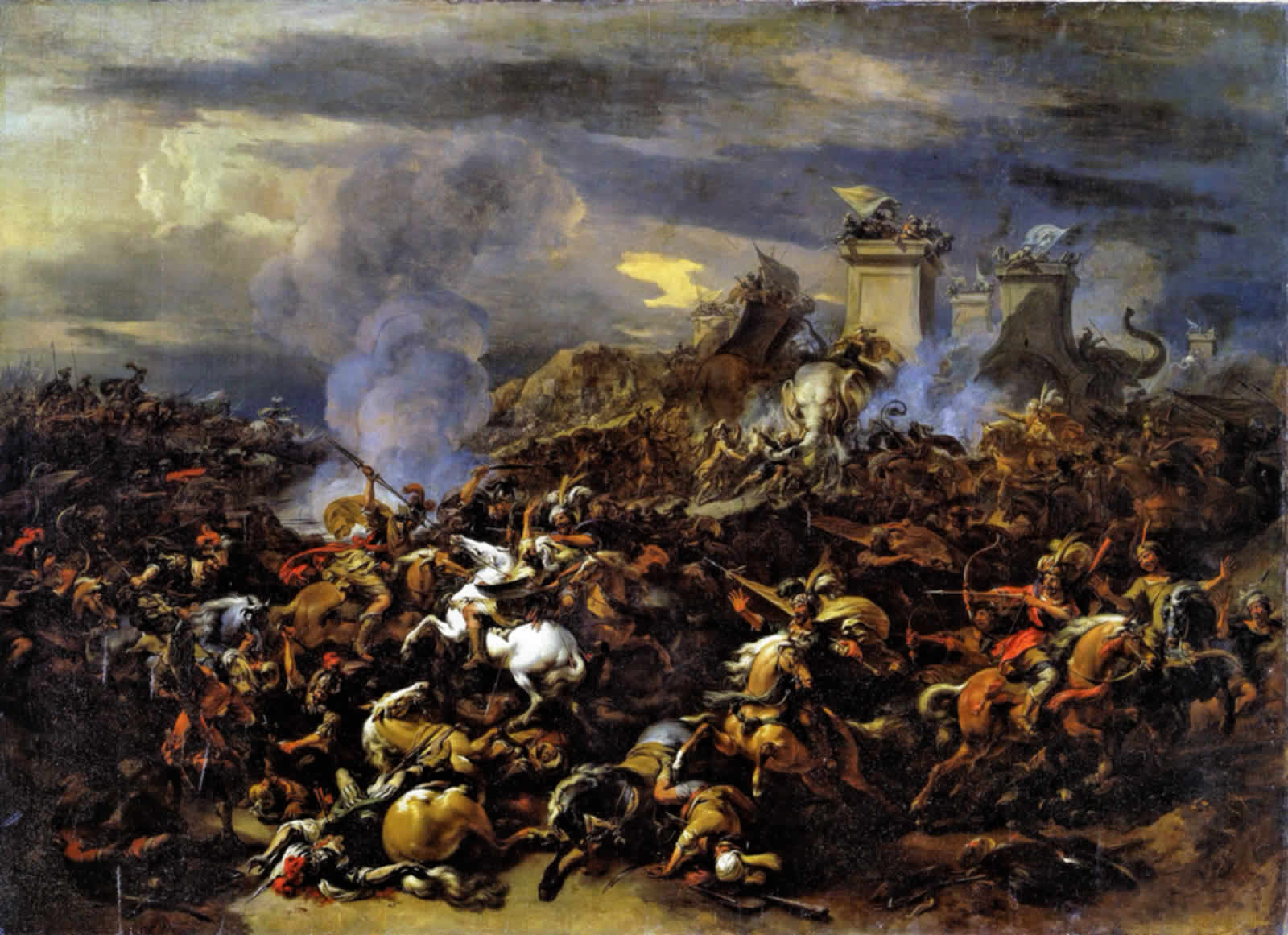
Alexander versus Maharaja Paurava (King Porus)
Click to see larger version.
My response:
James Ussher, the Anglican Archbishop of Armagh deduced that the first day of Creation began at nightfall preceding Sunday October 23, 4004 BC in the proleptic Julian calendar, near the autumnal equinox. Ussher chronology
This was widely believed to be true by most Christians in pre-Darwinian Europe including Sir William Jones. Jones who was a member of the Supreme Court of Calcutta, and founder of the Asiatic Society, lived in India from 1783 till his death in 1794. He was studying various sastras and Sanskrit literature with Bengali Pandits in Kolkata. It was Jones who famously noticed the similarity between Sanskrit, Latin, Greek and Persian; and you may say that he was the father of both Indology and linguistics.
In any case Mr. Jones while studying puranas found it difficult to fit the puranic timeline which spanned over 311 trillion years with that of the Bible, which stated that the world had been created about 5,794 years before. He wanted to make Indian history fit in with Noah and Moses. To do so he had to find the “linch pin” of ancient Indian history, that point in time where ancient European history intersected with India's. That point could only be 326 BC when Alexander the Great invaded India. Ancient Latin and Greek authors – Diodorus of Sicily, Curtius Rufus, Arrian of Nicomedia and Plutarch of Chaeronea wrote on the life of Alexander and mentioned the names of various Indian kings who were contemporary of Alexander. These were not in Sanskrit but in Greek forms, names such as Xandrames, Sandracottus, and Taxiles, etc.

Jones tried to find names of Indian kings similar to the Greek versions and deduced that it was Candragupta. The only problem was that there were two Candraguptas who founded dynasties – “Candragupta Maurya” and “Candragupta” of the Imperial Gupta dynasty who were 1200 years apart. In order to fit Indian history into his procrustean bed and make it agree with the Biblical version Jones purposely chose Candragupta Maurya as the contemporary of Alexander and thus neatly cut off 1200 years of Indian history. However, it was Candragupta and Samudragupta of the Imperial Guptas not Candragupta Maurya who were contemporaries of Alexander.
Subscribe to our mailing list. And get our intermittent newsletter and updates to this site.
Puranic Version
Kaliyuga began in 3101 B.C. According to the regnal dynsties recorded in the Vayu, Visnu, Matsya and Srimad Bhagavat Puranas it states that the Brhadratha Dynasty lasted for 1000 years, see Srimad Bhagavatam (SB) 9.22.46-48 and 9.22.49. (The count started at 3101 BC during Battle of Kurukshetra with the death of Sahadeva son of Jarasandha - not the Pandava.)
Then came Pradyota Dynasty which lasted for 138 years, see SB 12.1.3. 1 Then Sishunaga Dynasty for 362 years (Bhagavatam says 360), see SB 12.1.6-8. Then Nanda Dynasty which lasts for 100 years, SB 12.1.10.
1000+138+362+100=1600 therefore the Nanadas lasted till 1501 BC (3101 - 1600 = 1501).
The Nandas were destroyed by Canakya Pandita who then enthroned Candragupta Maurya (SB 12.1.11). Hence, Candragupta Maurya flourished circa 1537 BC, not 326 BC as Sir William Jones wanted to believe.
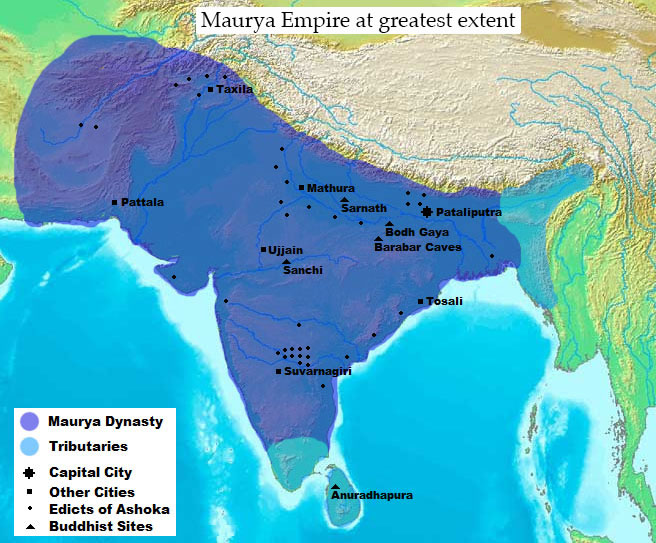
However, it was the British who were in control of the educational system, and especially with Macaulay they sought to destroy traditional Sanskrit education in India. Thus, the British enshrined their distorted history of India in all of the world's history books and schools. And, in the 225 years since Jones a lot of “scholarship” has added many thick encrusted layers to support this mistake. And, this is what we were all taught. However, since the independence of India there has been some effort to undo the damage done by the British, but a lot more is needed.
The mischief of the British was not only in relation to Candragupta Maurya, so much of Indian history was distorted it is hard to imagine the extent of the damage. For example Lord Buddha is not from the 6th BC but from 18th BC. Why? Ashokavardhana the grandson of Candragupta Maurya became a Buddhist and converted India to Buddhism. Buddha lived about 3 centuries before him. Hence 18th century BC.
The British also attempted to fit Aśoka into the third century B.C. based on the “Edicts of Aśoka.” For a detailed discussion see Emperor Aśoka and the Five Greek Kings.
This of course flies in the face of current academic historical dates for everything in early Indian history and mainstream scholars think it is madness and cries of “radical saffron revisionism” are heard.
However, there is one thing that you have to remember and that is when an artifact is found it doesn’t say on the back “made in 215 BC” or something similar. Dates if mentioned at all will be in regard to various epochs most often in the form of “year X in the reign of king Y” and all these pieces of the puzzle have to be sorted out and aligned with a known date. That is why who was contemporary to Alexander is so important and the “linch pin” because once that is known then you count backwards and forwards from that time. But since Jones purposely chose one that fit in with the Biblical timeline then all dating by scholars for the last 200 years has been in relation to the wrong date and the error magnified a million times over. And, considering that a lot of political pressure, academic prestige and reputations have been invested into this mistake it will take a lot of effort from courageous scholars to reverse it.
Cross cultural similarities
Other civilizations also had long histories. Berossus (fl. 280 BC), in his Bablyoniaca 2 , recounts the vast ages that preceded the Babylonian civilization and especially uses the number 432,000 years as a significant one in their history (the exact same length as Kali-yuga). He claimed that civilization was not the product of human action over time, contrary to the conventional Greek view of the early Hellenistic period, but was given intact by the gods to men at that early date. In the recorded fragments of his writings he tells how men had no civilization and behaved liked animals. Until a god, whose name he translates into Greek as Oannes, who had a body like a fish but with human appendages, came on the land and revealed all types of useful knowledge, both mundane and spiritual, to King Alorus and the people. This knowledge became the basis for human civilization. This occurred 432,000 years before the flood. According to various fragments of Berossus, the flood took place from 33,000 - 36,000 years before Alexander the Great. This incident with Oannes is remarkably similar to that of Matsya-avatara recounted in the Srimad Bhagavatam (SB 8.24), in which the fish incarnation of the Lord saves the Vedic knowledge and then redispenses it.
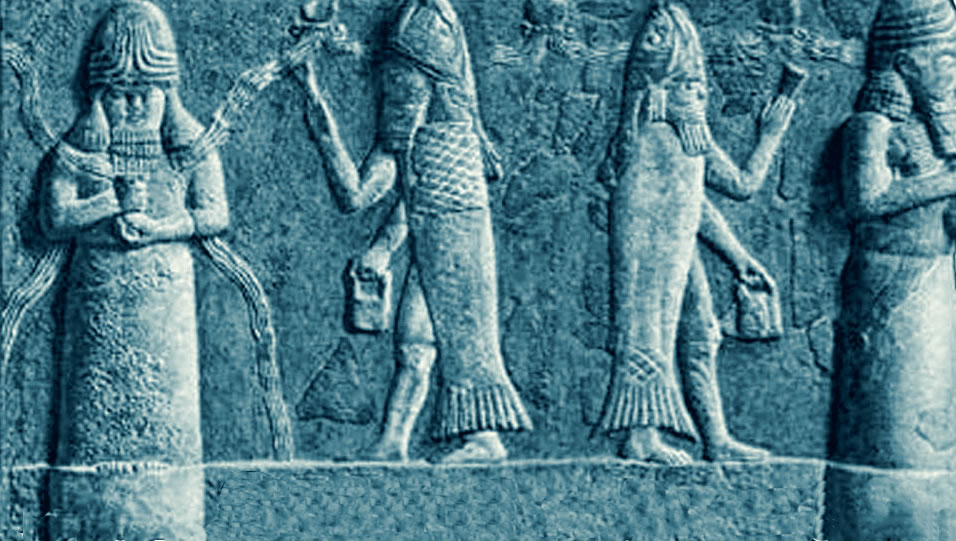
A Babylonian bas-relief of Oannes
Click to see larger version.
According to Porphyry (c. 300 AD), Callisthenes, the companion of Alexander the Great in the Persian wars, dispatched to his uncle, Aristotle, Babylonian records of eclipses that spanned 31,000 years. Iamblichus (4th century AD) claimed on the authority of the ancient Greek astronomer Hipparchus that the Assyrians had made observations for 270,000 years and had kept records for the return of all seven planets to the same position. 3 “Epigenes of Byzantium insisted that the Babylonians had tablets for 730,000 years of observation. . . Simplicius . . . . stated that Chaldean observations had extended over more than 1,440,000 years.” 4
The Egyptians, as recorded by Manetho (fl 300 BC), also had very vast histories dating back tens of thousands of years before the Hellenistic period in which he wrote. According to Eusebius 5 (fl 300 AD) , Manetho gives six dynasties of Kings that lasted for 24,925 years before the flood. And the Roman, Simplicius, stated that the Egyptians had records stretching back 630,000 years.6
Destruction of Ancient Historical Traditions
by Early Christians
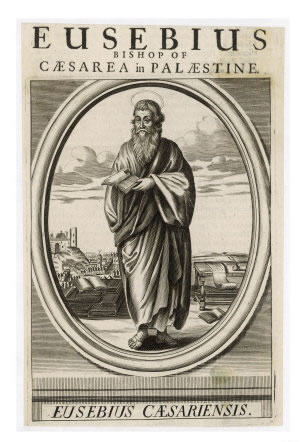
Clearly the peoples of classical antiquity didn't flinch when it came to long spans of time except for the Jews and especially the Christians. These vast time cycles all became mythologized, ridiculed and finally cut down by them to fit the Biblical timeline. We see from the Manetho fragments that the first known Christian scholar to alter beyond recognition the Egyptian historical time-line was Eusebius. This Christian scholar, historian, and friend of Emperor Constantine, in an attempt to align the history of Egypt with that of the Bible, felt no compunction in changing everything to suit himself. “In the introduction [of his Chronicles], Eusebius gives as one of his aims to ‘reprove the boasting of vainglorious chronographers.’”7 His problem was that the Bible contained very little history prior to about 1,500 BC. Everything was very murky and then there was the creation by Jehovah in seven days. Thus it was thought that the world was just newly created and hardly more than 4,000 years old. According to the Jewish calendar the date of creation was 3761 BC 8 This hardly allowed for Egyptian dynasties of 24,925 years. As a solution Eusebius changed all the years to months and thus was able to neatly compress the untidy sum of 24,925 years by a factor of twelve to 2206 [sic] solar years so that they fit into his Biblical notion of history. 9
However, recent research by egyptologist, John Anthony West, and geologist Robert M. Schoch strongly suggests that Manetho was correct and Eusebius wrong. West's investigations point to an Egyptian civilization very much older than anyone previously thought possible. In 1991 West and Schoch redated the Sphinx to 10,000-5000 BC. Their work was presented in a popular documentary.10
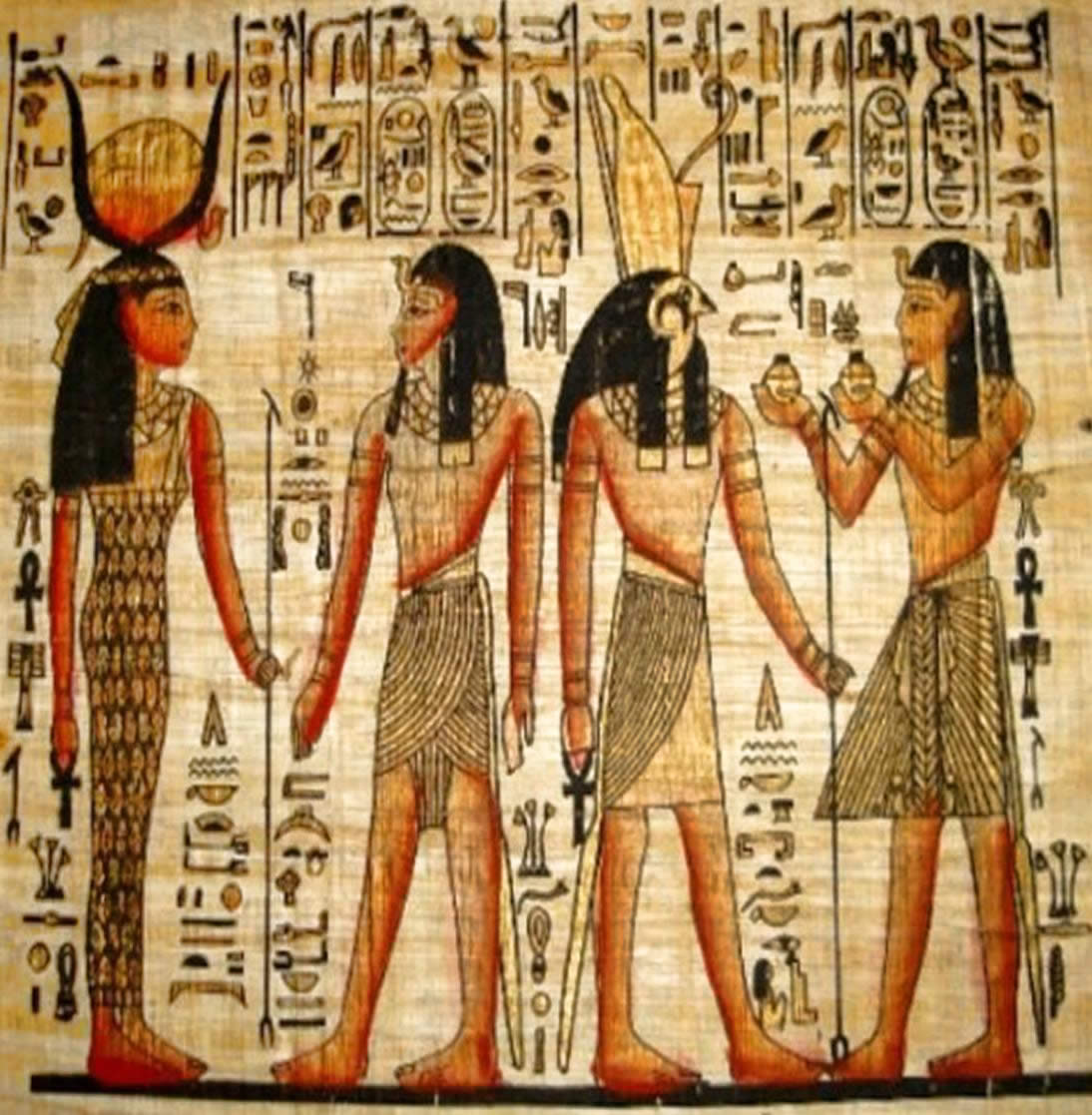
Egyptian Deities: Hathor on far left, and Horus 2nd from right with attendants ; both are holding ankhs the symbol of eternal life.
Click to see larger version.
Berossus suffered a similar fate:
This synchronism, however, was purely the product of Panodoros’ creative calculations. In order to bring the Babylonian and Egyptian antediluvian chronologies within the bounds of Biblical time, he adopted the principle that units of time had once been confused. In those primordial days before the flood, a year could mean a day, or a month, or a season. … In the case of Berossos, this was fairly straightforward. The massive Babylonian time period of the sar was, according to Panodoros, not 3,600 years but only 3,600 days, so the 120 sars of the 10 antediluvian kings in Berossos equaled 432,000 days not years. In other words (dividing those days into ‘real’ years): 1,183 years and 6 5/ 6 months. The Babylonian record of history, therefore, began in Anno Mundi 1059, a date that fits nicely within the antediluvian chronology of the Bible - and, moreover, allows Babylonian chronology to be subordinated to Biblical.11
Thus, the ancient history of several world civilizations have been put on the Christian chopping block and made to fit their procrustean bed. None have suffered worse than the Vedic culture. It is not that we automatically believe everything that an ancient culture may say about itself but we don’t disbelieve it either. The whole endeavor of modern secular historians, in continuation of their Christian inheritance, has been to cast out, as mythology and wild imagination, anything that doesn’t fit within their worldview of linear history.
We have hardly done justice to the subject but have at least adumbrated the types of arguments than can be made. The evidence strongly suggests that the British conquerors of India, all avowed Christians, starting with Sir William Jones et al., have totally distorted Indian history so that it practically has no resemblance with reality. Yet it is still taught in all schools in India and abroad.
Regarding the following quote by Srila Prabhupada:
That is a fact-the brahmanas were accepted. They formed the advisory committee of the king. For example, Candragupta, the Hindu king, was in the age of Alexander the Great. Just before Candragupta, Alexander the Great went from Greece into India and conquered a portion. When Candragupta became emperor, he had Canakya as his prime minister. Perhaps you have heard this name Canakya? Science of Self Realization
Srila Prabhupada was just repeating what is found in every textbook on ancient Indian history in the world, texts that were authored by the British and other Europeans or Indian collaborators.
I asked Hari Sauri Prabhu a similar question regarding a discussion about Ceylon versus Sri Lanka here was the critical part:
“So on some mundane topics, geography, historical claims, Srila
Prabhupada was not necessarily fixed. I think the key thing though is that
in the SB 4.22.36 purport mentioned above, he says " from historical
references in the Puranas”. Whenever there was some controversy or question
of authenticity, Srila Prabhupada would always refer to sastra. He would
often ask, “Is it in sastra. What do the Purana's say?””
So I have shown what the puranas say on the topic.
dasa dasa anu dasa
Shyamasundara Dasa
krsne matirastu
www.ShyamasundaraDasa.com
Footnotes
1 “Ripuñjaya” named in Srimad Bhagavatam 9.22.49 is the “Purañjaya” in Srimad Bhagavatam 12.1.1-2, the first two syllables in the names have been transposed.
2 Berossus, pp. 7, 13–24.
3 Cramer, p. 18.
4 Ibid.
5 Manetho, pp. 3–7.
6 Cramer, p. 10.
7 The World of Berossus, pp. 259, 267
8 AHD, p. 189.
9 Manetho, pp. 3–7. Footnotes in the book deserve special attention.
10 Mystery of the Sphinx, The Secrets of the Sphinx - Robert Schoch, Interview of Antony West, and Magical Egypt
11 The World of Berossus, p. 220
References
AHD - American Heritage Dictionary Of The English Language, The, 1969, New York: American Heritage Publishing House.
Berossus, 1980, translated by Stanley Mayer Burstein with introduction, The Babyloniaca of Berossus (Sources From the Ancient Near East Volume 1, Fascicle 5), Malibu, CA: Undena Publications.
Cramer, Frederick, 1954, Astrology in Roman Law and Politics, Memoirs of the American Philosophical Society Volume 37, Philadelphia: The American Philosophical Society.
Manetho, 1964, translated by W.G. Waddell, Manetho, History of Egypt and Other Works, The Loeb Classical Library Series, Cambridge, MA: Harvard University Press.
World of Berossos,The; Proceedings of the 4th International Colloquium on –The Ancient Near East between Classical and Ancient Oriental Traditions–, Hatfield College, Durham 7th-9th July 2010, 2013, edited by Haubold, Lanfanchi, Rollinger and Steele; Wiesbaden: Harrassowitz Verlag
